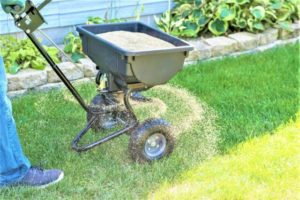
Full Lawn Broadleaf Weed Control with Liquid Broadleaf Herbicide – Every lawn in the area has weeds at this time of the year. Regardless of whether you had weeds in this spring, you’ve got ‘em now. Broadleaf weed plants (dandelions, clover, plantain, etc.) produce seeds which blow around or are transported to surrounding areas by birds, human feet, lawn mowers; lots of ways. If not removed with a fall application of liquid broadleaf herbicide, they will make you crazy next spring. A whole lawn application of liquid broadleaf herbicide will get rid of all broadleaf weeds now growing in your lawn. You can spot treat areas of the lawn, but do general areas as opposed to each plant; young weeds are often difficult to see. Remember, weed control application should be the first fall activity on your list (except if you have grubs), before seeding. Get rid of the weeds, wait 2 weeks, then seed. If you seed first, you can’t do weed control this fall, and then weeds will be in great profusion next spring. When applying herbicide, check the weather forecast; you don’t want any rain to fall for at least 12 hours after treatment, or the application may be less effective. Also, refrain from mowing 24 hours after treatment, so that the herbicide is better absorbed.
Controlling Crabgrass, Japanese Stiltgrass, and Yellow Nutsedge – Crabgrass and Japanese stiltgrass are both annual plants; seeds germinate in the spring and plants die in the fall when we get our first frost. The best control for annual grassy weeds is pre-emergent control, the elimination of the germinating seeds in the spring. There are now effective post-emergent control products, some are most effective when the weeds are small and newly emerged (early summer). BioAdvanced Extreme Crabgrass Killer however, will kill large crabgrass plants and Japanese stiltgrass.
Yellow nutsedge is a perennial sedge grass that cannot be controlled by broadleaf weed controls, and it can’t be controlled pre-emergently either because it is perennial (lives from year to year). Nutsedge grows in lawns and beds from nutlets (bulbs) that form off the roots of mature plants. The plants can be killed with applications of nutsedge-specific herbicides (Sedge Ender, SedgeHammer) while they are actively growing in late June, July and August. By September, next year’s nutlets have already formed, so killing the plant won’t reduce next year’s problem.
Grub Control in August/September – If you did not apply preventative grub control (Merit/Mallet) this past spring/early summer, and if you had significant beetle activity (Japanese beetles/Masked chafers) in July, you will be well advised to begin scouting for grub activity now. Grubs are the larval stage (1/2” white to grayish C shaped worm) of many beetles-primarily the Japanese beetle. Lawn areas that start to turn tan or brown may be caused from the feeding of these soil-inhabiting insects. The areas may feel spongy under foot or areas may be torn up by skunks, moles or birds feeding on the grubs. Give the turf the “tug test” by pulling up on the grass. If it lifts up easily and the grubs are found, apply BioAdvanced Hour Grub Killer Plus (DYLOX insecticide), and water it into the root zone. DYLOX insecticide kills grubs quickly to stop the damage.
Seeding/Overseeding Lawns in the Late Summer – In late summer/early fall, the earth is warm, rainfall is typically plentiful (fingers crossed), and as the nighttime temperatures cool, seed germination is excellent and relatively fast (particularly if supplemental irrigation is used). Seedling establishment in the fall favors rapid root establishment. This is when virtually all lawns will benefit from at least some overseeding. New, immature and damaged lawns should be seeded at the heavy rate (8-10 lbs./1,000 sq. ft.). Better established lawns should be overseeded at the reseed rate (4-6 lbs./1,000 sq. ft.). Even well-established lawns will benefit significantly from general overseeding after a good fall core aeration. We can’t stress strongly enough how getting seed down early (now through September, if possible) will improve your results before the end of the growing season.
Fertilizing in the Early Fall – Lawns, whether or not they have been fed once or twice in the spring, need an early fall feeding to aid in recovery from summer stress. The hot, dry conditions in July and August have left many lawns with turf damage and in need of being re-invigorated. As we enter the best growing time of the year, fertilization now (early fall), with Lawn Depot heavyweight granular turf food, is essential. More importantly, roots will continue to grow until late fall, thus lawns need to be fertilized again in late fall with Lawn Depot WINTERFEAST root thickening turf food. Lawns that are fed twice in the fall will recover quicker, look better, withstand difficult growing conditions better, and remain healthier than those that do not.
Core Aeration and/or Liming in the Fall. – Our acidic soils benefit from regular (annual) applications of pelletized lime to neutralize the acidity, and allow fertilizers to work better. Fall applications of fast acting lime (CAL-TURF PRO) are most effective when applied before November.
Core aeration (pulling soil plugs, not merely spiking the lawns) reduces soil compaction, thus allowing moisture (irrigation or rainfall) and fertilizer to enter deeper into the plants’ root zones where they’ll do the most good for healthy turf growth. Core aeration can be done whenever soil is soft enough to pull 2”-3” plugs (spring or fall) and the grass is growing actively. Core aerating heavily prior to any seeding is the best way to loosen/cultivate soils for better turfgrass establishment. It creates thousands of pockets where seed will germinate and really breaks up hard, bare areas for much better establishment of young grass. Core aerating regularly is the best thing you can do to build more roots growing in our heavy clay soils.
